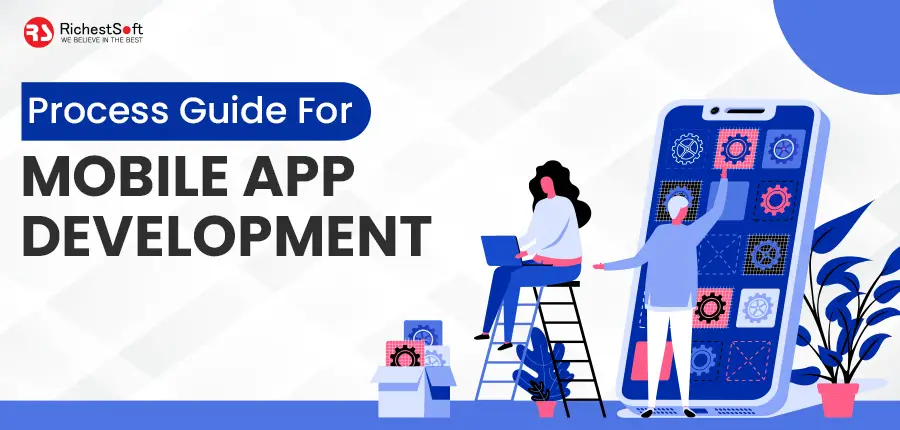With the advancement of technology, everything revolves around mobile technology these days. Nowadays, making a mobile application is not rocket science. Thus, the mobile application is a process that needs extensive pre-planning. The android app development company in India helps you to get the best mobile app development for your business.
The Basic Idea Behind a Mobile Application
As cliché as it may sound, great mobile applications are backed by a great idea. Anyone struggling with getting new ideas for the mobile app must develop their problem-solving skills. Identify the problems that people are facing or might be facing in the future and try finding their solutions.
Ask yourself these questions while finding solutions. What is the root cause of the problem? How can you eliminate the problem? Is there a better solution to the problem? Find answers to these questions, and you are halfway through finding better solutions to already existing problems.
Developing a mobile application requires a lot of time, and the feasibility of the app must be considered.
Feasibility of The Mobile Application
Once you have decided to develop a mobile app, the next process is to check its feasibility. Follow these steps before moving on with building a mobile app:
Know Competitors Apps
It is an important step, as it provides you the opportunity to learn from your competitors and save time by not making the same mistakes.
- Read the app reviews and find what users like and dislike about these apps.
- The number of downloads is also important as they give an idea about the popularity of similar apps.
- Search the problems these applications have faced in the past and how these apps have improved them.
- Find what these applications have done to increase their user base.
The main objective of this step is to learn from your competitors’ mistakes. Mistakes will not only make the app development process time-consuming but also expensive. Then, why not avoid making such mistakes by learning from your competitors?
The other objective is to understand the competition in the market. Are people happy with the existing apps or looking for new solutions? Understand the gaps between the solutions these apps are offering and the problem. Analyze how you can fill these gaps and provide a perfect solution. If your mobile app idea is completely new, look for other new apps and search how they are educating customers about their new products.
App Monetization
If you are building a mobile app just for fun or for social work, you can skip this step and move on to the next one. App monetization is one of the main aspects, and skipping this step in the future will only make getting a profit even harder. There are plenty of methods for app monetization such as in-app purchases, premium features, and ad revenue.
You need to consider these questions – what services do you offer for free? What time do you plan to monetize the app? What premium features does your app offer? Find the answers in advance to get an idea about the overall profit and how realistic it is to develop the mobile application.
App Marketing
Having a mobile app idea and creating great applications does not solve the purpose. Many apps in the app store go unused as no one knows much about them. Marketing plays a crucial role in reaching users that are interested in downloading the app and getting benefits from it. Allocate a marketing budget in advance to get an idea about the overall cost of the project.
Final App Road Map
The final step of this stage is to determine the road map of mobile app development. Set the goals that you want to achieve with this mobile app and plan a road map accordingly.
Plan what basic features your app must have for users to download and what features can be added later on or in the premium version. If there are features that you think a user might need in the future, plan to add them to the updated version. Making a road will make the development process more focused and future-ready.
User App Experience
This development process is focused on the feature in the application. Let us understand this process in detail:
App Information Structure
During this process, we write down the list of features an app needs to perform and where these features should be displayed. It gives an idea of how the data and functionality need to be organized. Based on this plan, build the wireframes.
App Wireframe
Whiteboards and papers are used during this process as it is easier to erase makes on a whiteboard than to rewrite code. Start creating screens and plans for each feature and data on that screen. Ensure every item has a home if something lives on multiple screens. After your different screens are finalized, start working on your app’s workflow.
App Workflow
App Workflow is the path that a user follows in an application. While planning the workflow, consider each thing you want your users to perform on the app. Check how many steps are needed to perform a particular function, and if more steps are required to accomplish a task, then there is a problem with your workflow. Update your wireframe as you encounter problems with the workflow. While updating the workflow does not increase the difficulty of one step to simplify the other.
Wireframe and Workflow Testing
Although the application has no functionality currently, you can test the wireframe and workflow. Check each page in the app and the navigation of the application. Fix the issues step by step with the workflow and wireframe, and update them until desired results are not skilled.
App Interface Design
App Style Guide – Various factors are considered while designing the interface of the application. An experienced designer decides the theme of an application depending on whether the app will be used in the daytime or at night. For applications that are used by busy professionals, a designer tries to simplify the interface.
You do not want your valuable feature to be blue at the bottom, but red at the top on the next page. These types of irregularities are removed during this stage. Having a uniform design will make users more engaged and comfortable with an application.
App Design Rendering – In this step, replace the wireframes and the gray elements with your style guide. Stay true to your style guide during the process and render the screen for each wireframe. Feel free to update and amend the app design, just make sure the design is consistent at the end of this stage.
App Rendered Click-through Models – After completing the above-mentioned steps, it is time to return to your click-through model and start testing again. Take your time while going through this process, after this, the changes will become costlier.
App Design to Development Handover
It is one of the significant stages in mobile app development. It sometimes amazes me how an application with such a brilliant idea takes more than the required time due to no proper realization by the development team. This issue is most common as most organizations and agencies only provide either design or development services.
It is highly recommended to go for a team that can provide both designs and development services to make the app development process more efficient. The most important thing is that your team does not simplify guessing at dimensions, colors, and positioning. The development team’s aim during this process is to be a pixel-perfect implementation of what the goal is during the design process.
Reliable Tech Stack
A mobile app can be built using different approaches, technologies, and programming languages. Every platform has its shortcomings and strengths, while some are relatively cheaper but less performing whereas others take a long time to implement and slow down the process.
The worst mistake anyone can make is to build the app on a dying or unreliable technology stack. One might end up rebuilding the whole application or be forced to pay a premium to move ahead. All these reasons make selecting the right tech stack important.
Front-End App Development
There are three approaches for front-end development. Here is an overview:
Platform-Specific Apps – Platform-specific apps are written separately for each mobile platform which are iOS and Android. The code written cannot be reused and is perfectly optimized for each platform. This approach is more time-consuming and expensive as the developer has to write separate codes for iOS and Android platforms.
Cross-Platform Apps – This approach is more cost-effective and time-saving as the same code can be used to run apps on iOS and Android platforms. React Native and Native Script is used to write the application code and can be easily optimized and styled for both platforms.
Hybrid Apps – Hybrid apps are built using web technologies like HTML and JavaScript. These can be installed using a native wrapper like Cordova and Phone Gap. It is one of the cheapest options among the others but has some shortfalls too.
Back-End App Development
Application performance and scalability are dependent on the server. Here are a few things that you should keep in mind before writing code:
Programming Language – Java, C#, PHP, and Python are some of the commonly used programming languages that are used for writing codes. Most programming languages have numerous frameworks that can be used.
Database – SQL and NoSQL are the two types of modern databases. SQL is more traditional and preferred most of the time over NoSQL. MSSQL and PostgreSQL are some of the familiar implementations of SQL. Designing a database schema is also useful, and reliable and well-organized data is also essential for the long-term success of apps.
App Hosting – Amazon AWS and Rackspace are common hosting providers. Selecting the right will determine the overall app performance, reliability, hosting costs, and scalability. You can also opt for cloud-based solutions as they help with database backup, server uptime, and app operating system updates.
Development And Testing Stage
The basics of mobile app development and testing are fairly simple. Break the development process into small steps, and each step will include planning, development, testing, and review. It is similar to sprints or agile methodology, and their plenty of books written on this, but that is not what we are discussing. Going with this approach will give you an overview of the completion of the project.
Planning Stage
By following the above-mentioned methodology, it is predominant to plan the small steps, and everyone should understand their role before moving forward to the development stage. Once you have finalized, it is easy for developers to analyze the time, and can distribute its workload. For skilled software developers, it becomes easy for them as they know at what stage they can reuse the code. If there is a need to change any design, it becomes easy as you do not have to update the code in many places.
Development Stage
During this stage, the development team will implement all the styles and functionality planned during the above stage, and as they finish, the project manager or QA tester will review their work. The manager needs to distribute the workload during this process to speed up the whole process.
Everyone needs to understand the intent behind the functionality of a feature and the goal behind an application. Usually, the developers are the first ones to notice if something is not up to the mark.
Testing Stage
To ensure more genuine testing in this stage, it should be performed by non-developers or those who are not your primary app developers. There are several types of testing during this stage that are –
Functional Testing – Usually, QA teams have a test plan with them to test the features and desired app behavior. Test the functionality and ensure that it matches the desired results.
Usability Testing – In this phase, ensure the feature being tested is user-friendly and as intuitive as possible. Bring in new testers if possible and get first-use experience from them.
Performance Testing – This is the foremost testing phase. In this, the responsiveness of the app is tested. An app can work perfectly, but if it takes more than 10 seconds to display, it is not adequate for an application.
Regression Testing – Good QA will test the previously tested feature, and do not assume it still works.
Testing For Specific Device – There are thousands of devices and operating systems in this world. Test your app for different screen sizes and OS versions. Some tools can help you in automating the process but always try to do it on physical devices.
Acceptance Testing – This is one of the most useful testing phases. There is no point in a feature to pass all the above tests but fails this one. The owner of the app or future users of the app will test the performance of the feature and give their feedback.
As problems get discovered during this process, assign the task to the developers accordingly, and they will solve the issues. When the testing is done, and all steps are completed you can move to the app review.
Review
After each small step, there is a review about what are the shortcomings and how we can improve and eliminate the issues in the future. If you can take away some important key points. Once the review is done, move back to the planning stage and repeat the whole process until the app is done.
Potential User App Review
When you reach this stage, your app has reached its fully testable stage, and all the features are ready to test. Before you make the app public and start spending money on marketing, it is always recommended to test your app with your potential users and get reviews from them. There are two main recommended methods for this.
Reviews From Small Focus Group
This stage involves interviewing a group of testers who have not seen this app before. Understand how these testers learn about new apps, and if they have ever used an app that is similar to your app. Try to know their background before pitching your app. Now, let them use their app, and don’t coach them the whole process to get honest reviews. Your goal is to let them use the app as if they have found the app on the app store.
Look for common problems they are facing and remember not to be too strongly guided by anyone tester. Always try to get and combine feedback and take decisions after getting from all of them.
Testing Beta Version
It is one of the most common testing approaches and also the most effective one when it comes to mobile app development. In this stage, a group of testers preferably the ones that are early adopters, power users, and possibly the potential future users of the apps.
Make sure you value their suggestion and let them know what changes you are making with the application to resolve the issues. It is recommended that you have sound crash reporting for this step. It is no good for an app if an issue goes undiscovered and diagnosed.
It is a great opportunity to test the app in beta as it performs on various devices, locations, operating systems, and under different network conditions.
Final Tweaks
Try to fix the issues that emerge during the above testing process and fix them as soon as possible. Continue testing and resolve the issues till the crash and issue report decline, and once your app is all-clear from your tester you can move on to the deployment stage.
Mobile App Deployment
There are two crucial mobile app deployments, one with your web server (API) and the other is Google Play Store and Apple App Store. Let us discuss them in detail –
Web Server (API)
For mobile apps that require a backend to function web servers are extremely important for them to transfer data to and fro from the mobile app. Configure your servers to match your user base and also potential use base if not done might result in servers getting overloaded, and the mobile app will stop working.
Cloud servers are extremely helpful when it comes to handling spikes in traffic. Popular cloud servers like Amazon web services and Rackspace will surely resolve your server issues.
Mobile App Store
Submit your apps on app stores like Google Play Store and Apple App Store. Before submitting the app make sure that your app is configured for release, fill out forms, and write descriptions and marketing material. For Apple stores, Apple manually reviews all apps submitted, and possibly (most of the time) they recommend some changes to comply with the regulations.
You can also discuss with them to accept the app as it is or you might have to do some final tweaks to be granted entrance. Once you submit the app it will be live on Google within a day or two, while for Apple it might take a few days if everything goes smoothly.
Mobile App Monitoring
For most mobile app development companies in India development process ends with the shipment of the app. You can see any moderately popular app and check their update from the time they were launched to date. This is enough to emphasize that monitoring is a must for any app to improve performance, fixes, and add new features. Here are some of the few things that should be monitored in a mobile app.
Application Crash Monitoring
It is important to track the crashes if any for fixing and improving mobile app development performance. Many libraries can be used to track these crashes and in addition to that, they also give information about the user’s device, what the user was doing, and other technical information that is important for the development team to fix that issue.
App Analytics
App analytics is extremely important for making mobile app development future-proof. Analyzing this data will help in building the user’s persona. It gives you an idea about what functionality is most used on the app. This will give you an idea about what buttons are clicked the most and you can use this information to understand where to invest your future efforts into.
Do not waste your efforts without getting the proper analytics. Instead, invest time in features that are most used by users and the possibility of potential growth.
App Store Management
Most users look for ratings and reviews before downloading a new app, and this even makes more sense. There is no point in downloading an app with bad reviews and later on ending up deleting the application. Ensure you engage with your users by thanking them for their good reviews. Try to solve the issue that people are facing. Many bad reviews get converted into 5-star ratings with just a little more effort from your side.
Tweaks And Developments
There is always a space for improving the performance of an application or even adding a new feature to the app. All this can be done if proper monitoring of the app is done. Use the information gathered during the app monitoring stage to continue to grow and improve. Repeat all the mobile development, fix the issues, make it more user-friendly, and continue increasing the conversion rates, the number of downloads, and revenue.
Final Words
The mobile development process involves a lot of steps and sometimes requires taking some hard decisions. You might want to skip one or two steps to speed up the whole process. But trust us that won’t prove time efficient at all. This process is built on our years of experience working as a mobile app development company. That is delivering the best services to our clients. This approach is extremely rewarding, and we can assure you.
Planning to build a mobile app and looking for top mobile app development companies in India then you are lucky. Our highly professional and experienced team will build the mobile app whether you are an entrepreneur or Fortune 50 company.
Source link







Leave a Reply